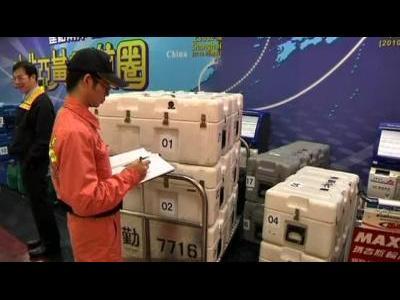 Reuters – Workers at the disaster response headquarters speak on telephones in Fukushima, northern Japan March …
Reuters – Workers at the disaster response headquarters speak on telephones in Fukushima, northern Japan March …SOMA, Japan – Japan's nuclear crisis deepened dramatically Tuesday. As safety officials sought desperately to avert catastrophe, the government said radioactive material leaking from reactors was enough to "impact human health" and the risk of more leaks was "very high."
In a nationally televised statement, Prime Minister Naoto Kan said that radiation has spread from four reactors of the Fukushima Dai-ichi nuclear plant in Fukushima province that was one of the hardest-hit in Friday's 9.0-magnitude earthquake and the ensuing tsunami.
He urged anyone within 19 miles (30 kilometers) of the plant to stay indoors or risk getting radiation sickness.
"The level seems very high, and there is still a very high risk of more radiation coming out," Kan said.
A cascade of three explosions at the Fukushima Dai-ichi nuclear complex was set in motion when last Friday's quake and tsunami knocked out power, crippling the cooling systems needed to keep nuclear fuel from going into full meltdown.
The latest blast was early Tuesday in the plant's Unit 2 near a suppression pool, which removes heat under a reactor vessel, plant owner Tokyo Electric Power Co. said. Shigekazu Omukai, a spokesman for Japan's nuclear safety agency, said the nuclear core was not damaged but that the bottom of the surrounding container may have been.
Chief Cabinet Secretary Yukio Edano said a fourth reactor at the complex was on fire and more radiation had been released.
"Now we are talking about levels that can damage human health. These are readings taken near the area where we believe the releases are happening. Far away, the levels should be lower," he said.
"Please do not go outside. Please stay indoors. Please close windows and make your homes airtight. Don't turn on ventilators. Please hang on your laundry indoors," he said.
"These are figures that potentially affect health, there is no mistake about that," he said.
Japanese officials had previously said radiation levels at the plant were within safe limits, and international scientists said that while there were serious dangers, there was little risk of a catastrophe like Chernobyl in Ukraine, where the reactor exploded and released a radiation cloud over much of Europe.
Unlike the plant in Japan, the Chernobyl reactor was not housed in a sealed container to prevent the release of radiation.
Japanese authorities have been injecting seawater as a coolant of last resort, and advising nearby residents to stay inside to avoid contamination.
"It's like a horror movie," said 49-year-old Kyoko Nambu as she stood on a hillside overlooking her ruined hometown of Soma, about 25 miles (40 kilometers) from the plant. "Our house is gone and now they are telling us to stay indoors.
"We can see the damage to our houses, but radiation? ... We have no idea what is happening. I am so scared."
Earlier blasts Monday and Saturday injured 15 workers and military personnel and exposed up to 190 people to elevated radiation. Officials said those explosions had been linked to the venting of buildups of steam at two of the troubled reactors and that they had not compromised their inner containers.
The nuclear woes compounded challenges already faced by the Tokyo government as it dealt with twin disasters that flattened entire communities and left as many as 10,000 or more dead.
It also raised global concerns about the safety of nuclear power at a time when it has seen a resurgence as an alternative to fossil fuels.
The head of the International Atomic Energy Agency said the Japanese government has asked the agency to send experts to help.
Japan's meteorological agency reported one good sign. It said the prevailing wind in the area of the stricken plant was heading east into the Pacific, which would help carry away any radiation.
 Play Video Reuters – International aid teams ready for Japan
Play Video Reuters – International aid teams ready for Japan ___
Yamaguchi reported from Tokyo. Associated Press writers Tim Sullivan in Bangkok contributed to this report.
http://news.yahoo.com/s/ap/20110315/ap_on_bi_ge/as_japan_earthquake_nuclear_crisis


No comments:
Post a Comment